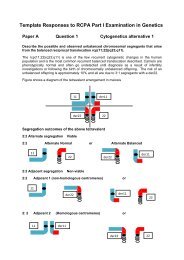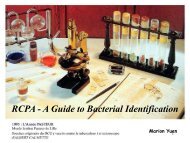RCPA Examinations in Anatomical pathology - Questions ... - Rcpa.tv
RCPA Examinations in Anatomical pathology - Questions ... - Rcpa.tv
RCPA Examinations in Anatomical pathology - Questions ... - Rcpa.tv
You also want an ePaper? Increase the reach of your titles
YUMPU automatically turns print PDFs into web optimized ePapers that Google loves.
Case 13: Male 65 – tumour at the<br />
base of ur<strong>in</strong>ary bladder<br />
• MICROSCOPIC<br />
• There are multiple fragments of adenocarc<strong>in</strong>oma present. There is crush<br />
artefact. The carc<strong>in</strong>oma has a papillary and glandular pattern. The<br />
glandular and papillary structures are l<strong>in</strong>ed by columnar to pseudostratified<br />
columnar epithelium. Mitoses are numerous. No prostatic tissue can be<br />
identified. There is a fragment of smooth muscle and fibrous tissue<br />
consistent with bladder wall.<br />
• Comment<br />
• There is an adenocarc<strong>in</strong>oma present. At the base of the bladder this is<br />
more likely to represent a prostatic adenocarc<strong>in</strong>oma rather than a primary<br />
bladder adenocarc<strong>in</strong>oma. Immunoperoxidase sta<strong>in</strong>s for PSA and PAP would<br />
be performed. As the morphology of the tumour favours a prostatic ductal<br />
adenocarc<strong>in</strong>oma these would be expected to be positive to confirm the<br />
diagnosis. If the PSA and PAP are negative <strong>in</strong>vestigations to exclude the<br />
possibility of a metastatic adenocarc<strong>in</strong>oma (eg CEA) will be undertaken.<br />
• SUMMARY<br />
• Bladder: Large duct carc<strong>in</strong>oma of prostate

















